Attracting the charming Blue Tit (Cyanistes caeruleus) to your garden can be a rewarding experience for bird enthusiasts. These small, vibrant birds bring life and color to outdoor spaces, and one of the most effective ways to invite them in is by offering the right food.
Selecting the best foods to attract Blue Tits requires an understanding of their dietary preferences and nutritional needs. By providing a diverse range of high-quality foods, you can create a welcoming environment that not only entices these delightful birds but also supports their health and well-being.
From sunflower hearts and peanuts to suet and mealworms, the choices are plenty, and each food item plays a crucial role in encouraging Blue Tits to make your garden their regular dining destination.
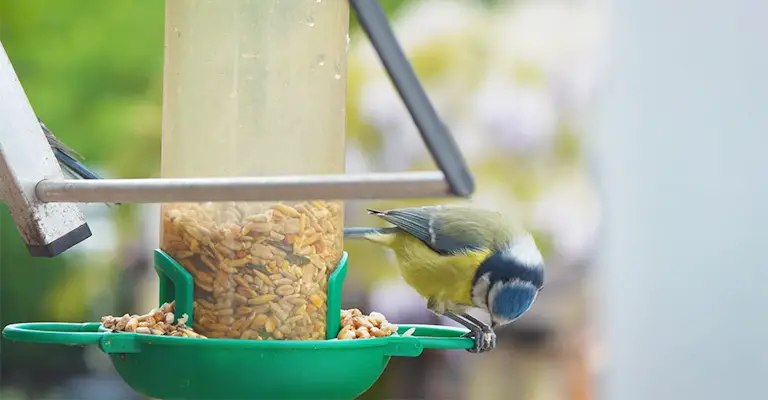
Best Food To Attract Blue Tits?
Blue tits are beautiful and lively birds that can brighten up any garden. They are also easy to attract with a variety of foods that they enjoy.
Here are some foods that you can offer to blue tits to entice them to visit your garden:
Peanuts
Peanuts are a great source of protein and fat for blue tits, especially in winter when insects are scarce. Peanuts can also help blue tits to grow their feathers and keep them warm.
You can offer whole peanuts in a mesh feeder or chopped peanuts in a tray or dish. Make sure the peanuts are unsalted and fresh, as moldy peanuts can be harmful to birds.
Sunflower Seeds
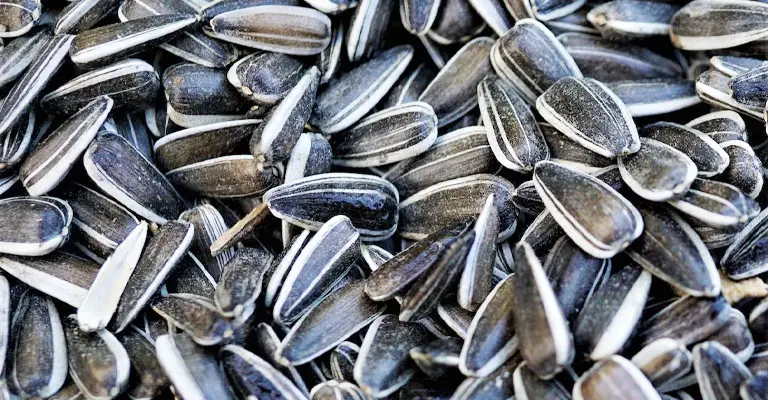
Sunflower seeds are another nutritious food for blue tits, as they contain high levels of oil and energy. Sunflower seeds can be offered in a seed feeder or mixed with other seeds in a bird table.
Black sunflower seeds are preferred by blue tits, as they have thinner shells and larger kernels than striped sunflower seeds.
Mealworms
Mealworms are a favorite food for blue tits, as they mimic their natural diet of insects and caterpillars. Mealworms are rich in protein and moisture and can help blue tits to feed their chicks in spring and summer.
You can offer live or dried mealworms in a shallow dish or tray or sprinkle them on the ground. You can also soak dried mealworms in water to rehydrate them before offering them to blue tits.
Suet Balls
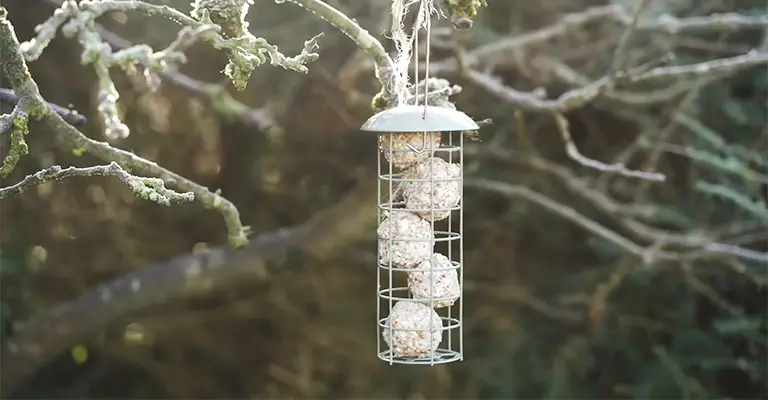
Suet balls are another excellent food for blue tits, as they provide them with fat and energy. Suet balls can be hung from a feeder, a branch, or a wire or placed on a bird table or tray.
You can also make your own suet balls by mixing suet with seeds, nuts, dried fruits, or cheese. Suet balls are especially beneficial for blue tits in winter when they need extra calories to survive the cold.
Cheese
Cheese is a tasty treat for blue tits, as it contains protein and calcium. Cheese can be grated or crumbled and offered in a dish or tray or mixed with other foods such as suet or seeds.
You can also use cheese to fill holes in trees or logs, where bluetits can peck at it. Make sure the cheese is mild and hard, such as cheddar or edam, as soft or blue cheeses can be too salty or moldy for birds.
Fruit
Fruit is a good food for blue tits, as it provides them with vitamins and antioxidants. Fruit can be chopped or sliced and offered in a dish or tray or hung from a feeder, a branch, or a wire.
You can also use fruit to make kebabs by threading pieces of fruit onto a skewer or string. Some fruits that blue tits enjoy are apples, pears, grapes, cherries, berries, and bananas.
Niger Seeds
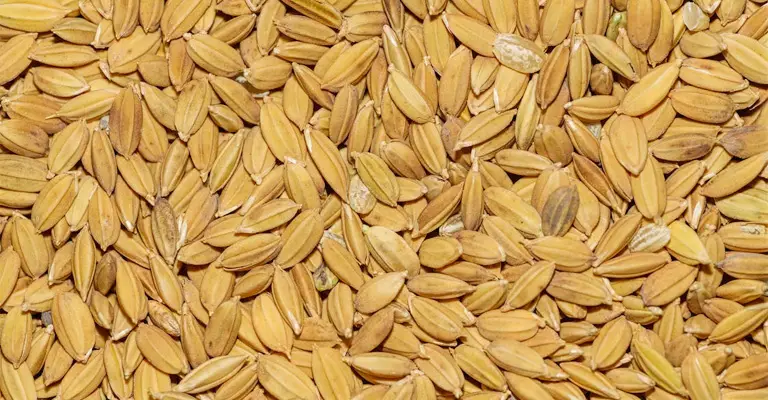
Niger seeds are small black seeds that are rich in oil and protein. Niger seeds are attractive to blue tits, as they resemble the seeds of plants that they feed on in the wild.
Niger seeds can be offered in a special niger seed feeder, which has tiny holes that prevent the seeds from spilling out. You can also mix niger seeds with other seeds in a bird table or tray.
Coconut
Coconut is a fun food for blue tits, as it allows them to use their acrobatic skills to access the meat inside. Coconut is also nutritious for blue tits, as it contains fat and fiber. You can offer half a coconut shell with the meat still inside and hang it from a feeder, a branch, or a wire.
You can also drill holes in the coconut shell and fill them with suet or cheese. Make sure the coconut is fresh and unsweetened, as dried or sweetened coconut can be harmful to birds.
Oats
Oats are a healthy food for blue tits, as they contain carbohydrates and fiber. Oats can help blue tits to maintain their energy levels and digestion. You can offer rolled oats or oatmeal in a dish or tray or mix them with other foods such as suet or cheese.
You can also cook oats with water and let them cool before offering them to blue tits.
Bread

Bread is an easy food for blue tits, as it is readily available and cheap. Bread can provide some starch and energy for blue tits, but it should not be offered too often or too much, as it has low nutritional value and can fill up their stomachs without satisfying their needs.
You can offer small pieces of bread in a dish or tray or sprinkle them on the ground. Make sure the bread is fresh and moist, as stale or dry bread can be hard to swallow or choke on.
You can also soak bread in water or milk to soften it before offering it to blue tits.
Pumpkin Seeds
Pumpkin seeds are a seasonal food for bluetits, as they are available in autumn when pumpkins are harvested. Pumpkin seeds are beneficial for blue tits, as they contain protein, fat, and minerals.
You can offer pumpkin seeds in a dish or tray or mix them with other seeds on a bird table. You can also use pumpkin seeds to make suet balls by mixing them with suet and cheese.
You can also leave a whole pumpkin in your garden and let bluetits peck at the seeds and flesh inside.
These are some of the best foods that you can offer to blue tits to attract them to your garden. By providing a variety of foods, you can ensure that blue tits have a balanced and diverse diet that meets their needs.
You can also provide fresh water in a birdbath or a shallow dish and plant native trees and shrubs that provide natural food and shelter for bluetits.
By doing these things, you can create a welcoming and friendly environment for blue tits and enjoy their beauty and antics all year round.
How Do You Attract Blue Tits?
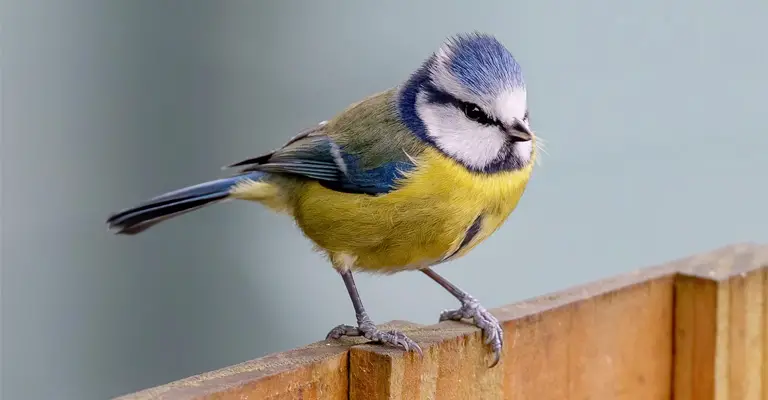
Attracting Blue Tits to your garden can be a delightful experience, and employing specific gestures and strategies can make your garden more inviting to these charming birds.
Here are some ways to attract Blue Tits:
Provide Bird Feeders
Place a variety of bird feeders around your garden filled with suitable foods like sunflower hearts, peanuts, and suet. Blue Tits are attracted to feeding stations where they can easily access their favorite treats.
Offer Fresh Water
Install a bird bath or shallow water dish to provide a source of clean, fresh water. Blue Tits, like all birds, require water not only for drinking but also for bathing and preening.
Plant Native Trees And Shrubs
Choose native trees and shrubs that produce berries or seeds attractive to Blue Tits. These plants can provide natural foraging opportunities and shelter.
Nesting Boxes
Provide nesting boxes or birdhouses with suitable dimensions and entrance holes to accommodate Blue Tits. Placing these in a sheltered location can encourage them to nest in your garden.
Avoid Chemicals
Minimize the use of pesticides and herbicides in your garden, as these chemicals can harm insects, which are a vital food source for Blue Tits.
Offer Nesting Materials
During the spring, leave out materials like twigs, moss, and feathers that Blue Tits can use to build their nests. These gestures can make your garden more attractive for nesting pairs.
Patience And Observation
Spend time observing the birds in your garden and be patient. Blue Tits, like all wildlife, may take some time to discover and trust new feeding and nesting opportunities.
By implementing these gestures and maintaining a bird-friendly environment, you can increase the likelihood of attracting and supporting Blue Tits in your garden, creating a haven for these colorful and lively little birds.
How Do Blue Tits Find Food?
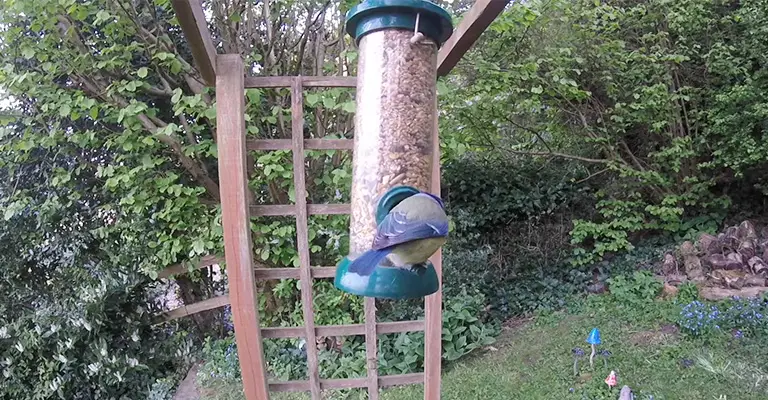
Blue Tits, small and agile birds, employ various techniques to find food efficiently. Here are some ways Blue Tits locate their primary food sources:
Foraging
Blue Tits are skilled foragers, often searching for insects, spiders, and caterpillars among leaves, branches, and crevices. They use their sharp beaks to probe and peck at potential food items.
Gleaning
Gleaning involves inspecting the surfaces of leaves and twigs for small insects and larvae. Blue Tits are adept at this method, using their keen eyesight to spot tiny prey hiding amidst foliage.
Hawking
Blue Tits engage in hawking, which entails catching flying insects mid-air. They are agile fliers, capable of making quick, darting movements to capture small insects on the wing.
Hovering
Blue Tits can hover momentarily while searching for insects or spiders on the undersides of leaves or within vegetation. This hovering behavior allows them to access prey in hard-to-reach locations.
Pecking
Pecking is a common behavior employed by Blue Tits to extract insects or seeds from bark, branches, or fruits. Their strong beaks enable them to access hidden food sources in this manner.
Probing
Blue Tits are known to probe into crevices and cracks in search of insects, especially during the winter months when insects may hide in tree bark or other shelters.
Feeding Stations
Blue Tits are frequent visitors to bird feeders, where they access readily available food sources like sunflower seeds, peanuts, and suet. These feeders provide a convenient and consistent source of nutrition.
Blue Tits exhibit a versatile and opportunistic feeding strategy, allowing them to adapt to a wide range of food sources and foraging techniques.
Their ability to employ these various methods ensures their survival in diverse environments and throughout different seasons.
FAQs
What is the best food to attract Blue Tits to my garden?
The best foods to attract Blue Tits are sunflower hearts, peanuts, suet, mealworms, and nyjer seeds. These foods cater to their dietary preferences and provide essential nutrients and energy.
Can I feed Blue Tits with bread and scraps from my kitchen?
While Blue Tits may occasionally eat bread and kitchen scraps, it’s not the best option. These foods lack the essential nutrients that Blue Tits need for their health. It’s better to offer high-quality, bird-specific foods for their well-being.
Should I offer live insects to attract Blue Tits?
Yes, Blue Tits love live insects, especially during the breeding season when they are feeding their chicks. Providing live mealworms or other insects can be a highly effective way to attract and support these birds.
Do I need special feeders for Blue Tits?
Specialized feeders, such as mesh feeders for peanuts or suet cages, can make it easier for Blue Tits to access their favorite foods. However, they can also feed from standard bird feeders, particularly if the food is suitable.
How can I ensure the food I offer stays fresh for Blue Tits?
To keep food fresh, store it in a cool, dry place and use appropriate feeders that protect the food from moisture and contamination. Clean the feeders regularly to prevent mold or bacteria growth, ensuring the food remains safe and attractive to Blue Tits.
Conclusion
In the world of birdwatching and garden bird feeding, attracting Blue Tits is a delightful accomplishment.
By offering a well-balanced menu of sunflower hearts, peanuts, suet, mealworms, and other suitable foods, you not only cater to their nutritional needs but also foster a thriving bird-friendly ecosystem.
Your garden becomes a haven for these small wonders, where they can find sustenance and shelter. Remember that providing fresh, high-quality food in appropriate feeders and complementing it with fresh water ensures a continuous welcome for Blue Tits and other avian visitors.
In this harmonious interaction between humans and nature, we can admire the beauty of Blue Tits while contributing to their well-being and conservation.